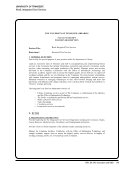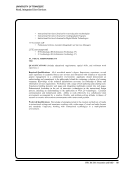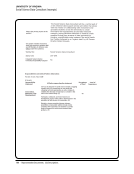18 · Survey Results: Executive Summary
thought that innovation should be infused through-
out the organization and investment is embedded in
the regular budget process. Or perhaps it is a reality
of library budgets that after accounting for collections
and salary expenditures, many libraries have very
little budgetary flexibility.
The majority of respondents stated they were inter-
ested in innovation in order to support their library’s
and/or institution’s mission. Libraries have an oppor-
tunity to play a larger role in university-level research
activities and library R&D activities will support that
role. One of the responses summed up the tenor of the
responses quite clearly.
“We clearly see increased attention to innovation
and research and development efforts as we look
to meet the changing needs of our users and con-
tinue to improve internal operations processes. To
date, these have been somewhat ad hoc/project-
based efforts, but we anticipate developing a more
formalized approach to funding and otherwise
supporting R&D within the library.”
A number of responses recognized the value of
pursuing innovative activities within existing part-
nerships like the Library of Congress National Digital
Stewardship Alliance and other government agen-
cies, consortia like the Committee on Institutional
Cooperation (CIC), cultural organizations, and com-
munity partners.
ARL libraries are achieving innovation at the mac-
ro level with initiatives such as HathiTrust, Shared
Print Preservation Networks, and the Digital Public
Library of America. This ability to collaborate and to
bring concerted resources to bear on very large-scale
problems was not mentioned very often in this survey,
but it is a uniquely powerful element of library culture
and may be driving the innovative and R&D wheels
at our institutions.
Figure 3. Descriptions of the Future Role of Innovation in Libraries Word Cloud
thought that innovation should be infused through-
out the organization and investment is embedded in
the regular budget process. Or perhaps it is a reality
of library budgets that after accounting for collections
and salary expenditures, many libraries have very
little budgetary flexibility.
The majority of respondents stated they were inter-
ested in innovation in order to support their library’s
and/or institution’s mission. Libraries have an oppor-
tunity to play a larger role in university-level research
activities and library R&D activities will support that
role. One of the responses summed up the tenor of the
responses quite clearly.
“We clearly see increased attention to innovation
and research and development efforts as we look
to meet the changing needs of our users and con-
tinue to improve internal operations processes. To
date, these have been somewhat ad hoc/project-
based efforts, but we anticipate developing a more
formalized approach to funding and otherwise
supporting R&D within the library.”
A number of responses recognized the value of
pursuing innovative activities within existing part-
nerships like the Library of Congress National Digital
Stewardship Alliance and other government agen-
cies, consortia like the Committee on Institutional
Cooperation (CIC), cultural organizations, and com-
munity partners.
ARL libraries are achieving innovation at the mac-
ro level with initiatives such as HathiTrust, Shared
Print Preservation Networks, and the Digital Public
Library of America. This ability to collaborate and to
bring concerted resources to bear on very large-scale
problems was not mentioned very often in this survey,
but it is a uniquely powerful element of library culture
and may be driving the innovative and R&D wheels
at our institutions.
Figure 3. Descriptions of the Future Role of Innovation in Libraries Word Cloud


































































































































































































